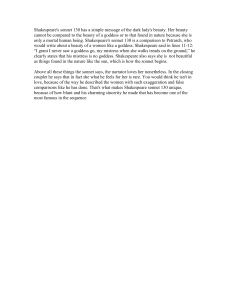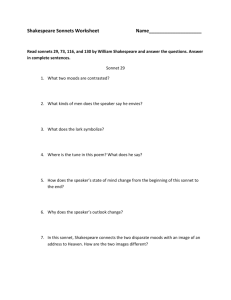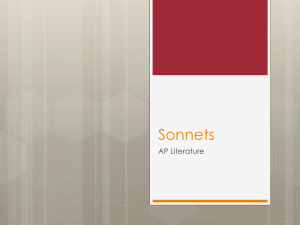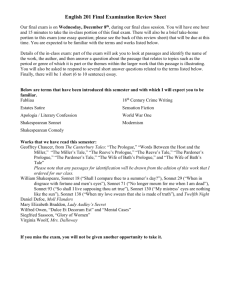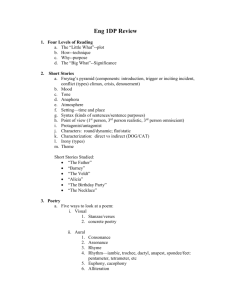Lesson Plan Template
advertisement
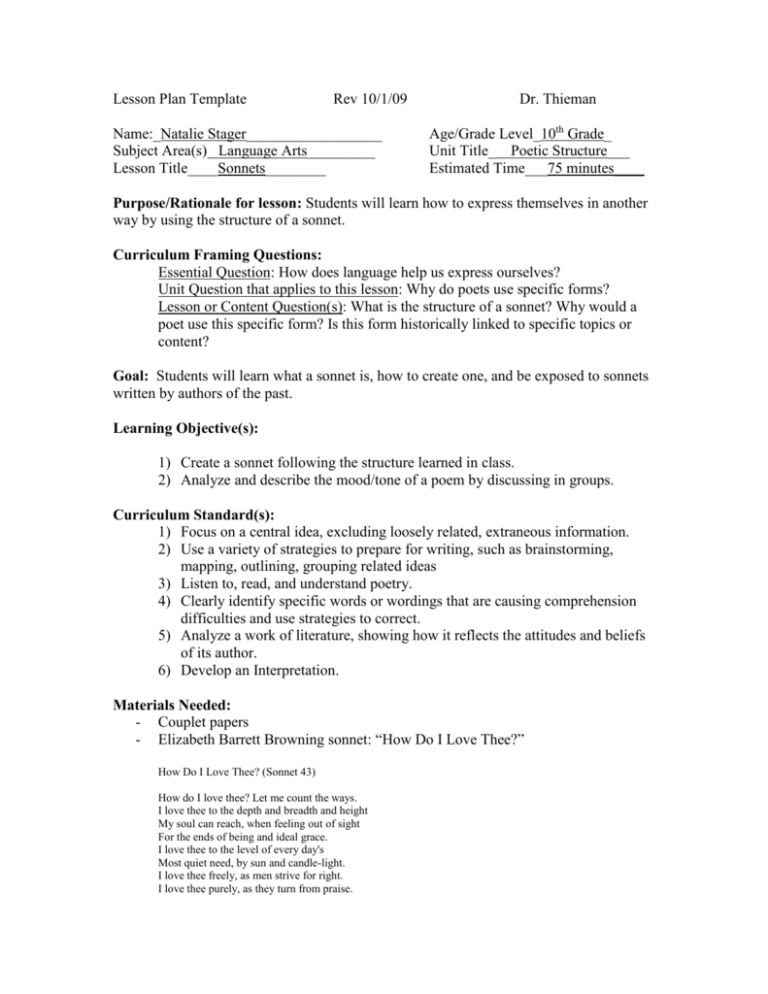
Lesson Plan Template Rev 10/1/09 Name:_Natalie Stager__________________ Subject Area(s) Language Arts_________ Lesson Title____Sonnets________ Dr. Thieman Age/Grade Level_10th Grade_ Unit Title_ Poetic Structure___ Estimated Time___75 minutes____ Purpose/Rationale for lesson: Students will learn how to express themselves in another way by using the structure of a sonnet. Curriculum Framing Questions: Essential Question: How does language help us express ourselves? Unit Question that applies to this lesson: Why do poets use specific forms? Lesson or Content Question(s): What is the structure of a sonnet? Why would a poet use this specific form? Is this form historically linked to specific topics or content? Goal: Students will learn what a sonnet is, how to create one, and be exposed to sonnets written by authors of the past. Learning Objective(s): 1) Create a sonnet following the structure learned in class. 2) Analyze and describe the mood/tone of a poem by discussing in groups. Curriculum Standard(s): 1) Focus on a central idea, excluding loosely related, extraneous information. 2) Use a variety of strategies to prepare for writing, such as brainstorming, mapping, outlining, grouping related ideas 3) Listen to, read, and understand poetry. 4) Clearly identify specific words or wordings that are causing comprehension difficulties and use strategies to correct. 5) Analyze a work of literature, showing how it reflects the attitudes and beliefs of its author. 6) Develop an Interpretation. Materials Needed: - Couplet papers - Elizabeth Barrett Browning sonnet: “How Do I Love Thee?” How Do I Love Thee? (Sonnet 43) How do I love thee? Let me count the ways. I love thee to the depth and breadth and height My soul can reach, when feeling out of sight For the ends of being and ideal grace. I love thee to the level of every day's Most quiet need, by sun and candle-light. I love thee freely, as men strive for right. I love thee purely, as they turn from praise. I love thee with the passion put to use In my old griefs, and with my childhood's faith. I love thee with a love I seemed to lose With my lost saints. I love thee with the breath, Smiles, tears, of all my life; and, if God choose, I shall but love thee better after death. - Shakespeare sonnet: “My Mistress’ Eyes Are Nothing Like the Sun” (handout) My mistress' eyes are nothing like the sun; Coral is far more red than her lips' red; If snow be white, why then her breasts are dun; If hairs be wires, black wires grow on her head. I have seen roses damask'd, red and white, But no such roses see I in her cheeks; And in some perfumes is there more delight Than in the breath that from my mistress reeks. I love to hear her speak, yet well I know That music hath a far more pleasing sound; I grant I never saw a goddess go; My mistress, when she walks, treads on the ground: And yet, by heaven, I think my love as rare As any she belied with false compare. - Link to Alan Read’s dramatic reading of Shakespeare sonnet: http://www.youtube.com/watch?v=xP06F0yynic - *Alternate handout for student with special needs Background knowledge or skills students need prior to lesson: Vocabulary: poem, syllable, rhyme. Hook or Introduction: As students walk in the classroom, hand each person a colored piece of paper with a couplet from a sonnet and tell them not to share it with anyone else. Have different areas of the room labeled with the colors corresponding to the slips of paper so the students know what groups of seven to sit in. On the screen will be 3-4 lines from different sonnets and the question: “What is similar about all of these lines?” The students will have 5 minutes to discuss amongst their group (I will tell them this) and will then report back to the class. The answer is that they are all written in Iambic Pentameter, which will lead into me teaching them about sonnets, including what Iambic Pentameter is. *(10 minutes) Procedures: Step 1: Teach the history of a sonnet: - No official date, created by 1200s - Originated from Italian word “sonneto” = “little song” - Shakespeare’s (1564-1616) Sonnets o 154 sonnets o Published in 1609 o English sonnet form *(5 minutes) Step 2: Teach the structure of a sonnet: - 14 lines, 7 couplets - 10 syllables per line switching between stressed and unstressed syllables (Iambic Pentameter) (Demonstrate how to count syllables) - 4 quatrains (first 4 lines, second 4 lines, third 4 lines, last two lines) - Rhyme scheme abab/cdcd/efef/gg - Trying to get a point across/ talking about one subject, conclusion in last couplet - Show example: Browning’s “How Do I Love Thee?” *(20 minutes) Step 3: Instruct each color group to try to piece together the sonnet as a group. Once they have compiled their sonnets, have the groups read their sonnets aloud, with each member reading the couplet that they were given at the beginning of class. Next, I will put the sonnets up on the screen and allow each group to check whether or not they put their sonnet together correctly. *(10 minutes) Step 4: Pass out copies of Shakespeare’s “My Mistress’ Eyes Are Nothing Like the Sun” to the class while also projecting it on the screen. I will play a dramatic reading of the sonnet from a YouTube clip of Alan Reads reading it and tell them not to write anything, but just to listen. Then, I will play it one more time and tell them to note anything that jumps out to them- is any word or image repeated? Is there a word you don’t know? - as they read along on their paper. *(5 minutes) Step 5: The students will then be put into groups of four (I will number them off) and discuss anything they had questions on, what they think the meaning of the poem is, the tone or mood of the piece, etc. *(5 minutes) Step 6: Give students time to write about what they discussed. *(5 minutes) Step 7: I will tell the students to think about their weekend. We will then move into having the students write their own sonnet by having them brainstorm about a topic related to their weekend by drawing a concept map, a picture, or writing a paragraph about the topic they might want to write about. (Give examples, options). *(5 minutes) Step 8: Students will work independently on their sonnets. Their homework will be to finish their sonnet and bring a word-processed version to the next class period. *(10 minutes) Step 9: Students will turn in their writing about Shakespeare’s sonnet and as the leave the class. Differentiation/Accommodation for diverse learners in your classroom. 1) TAG Student: I would give the TAG student in my class a more specific and challenging question to answer about the Shakespeare sonnet instead of just having them discuss what they think it means- how does Shakespeare use metaphor in this piece? For the homework I would require them to use at least 3 metaphors in their sonnet. 2) Student with ADHD: I would make sure that I place them with a group that is a bit more patient and possibly less excitable. If they have issues with written work, I could have them do the in-class writing as homework and have the write half of a sonnet, or I could have them tell me what they think about the poem orally instead. If they have problems with reading, I could have them read and analyze parts of the sonnet, but still participate in the group discussions. I could also have them do the sonnet in sections, maybe just 2 quatrains at a time and have it due 2 class periods later instead of the next one. 3) Student that reads 3 grade levels below (7th grade level): Make a special handout of the Shakespeare sonnet for them that includes challenging vocabulary at the bottom with definitions or possibly even put an easier word next to the harder ones in parenthesis. Attention to Literacy: Teaching vocabulary: Sonnet, Iambic Pentameter, Couplet, and Quatrain. We will also read and analyze Shakespeare’s sonnet. Closure: The students will be working on their sonnets for next class. Assessment and Evaluation of Student Learning: I will grade participation in the class by walking around while groups are discussing and while they are brainstorming to make sure that they are actually working as well as having them turn in the writing they do about Shakespeare’s sonnet. As long as they have done the writing and at least explored something about the poem, they will receive full participation points on that assignment. This score, along with how they worked in class, will determine their participation score for the day out of 5 (group work and brainstorming = 2 points, Shakespeare writing = 3 points). Students will also be evaluated on the sonnet that they do for homework based on whether or not they followed the sonnet structure. The assignment will be out of 10, little to no mistakes- minus 0-2 points, a few mistakes- minus 3-5 points, many mistakesminus 6-8 points.

